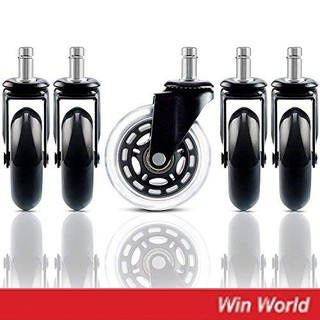Office Chair Casters: What They Are, How They Work, and How to Choose Them
If you have ever used an office chair, you have probably noticed the small wheels attached to the bottom of the chair legs. These wheels are called casters, and they are essential for the mobility and functionality of your office chair. But what are casters exactly, and how do they work? And more importantly, how do you choose the best casters for your office chair and your floor type? In this article, we will answer these questions and help you understand the types, functions, and benefits of office chair casters.

What are Office Chair Casters?
Office chair casters are pivoting rollers that allow the chair to move and roll on the floor. A caster consists of a wheel, a fork, a stem, and a mount. The wheel is the part that contacts the floor and rotates around an axle. The fork is the part that holds the wheel and connects it to the stem. The stem is the part that inserts into the chair base and allows the caster to swivel. The mount is the part that attaches the stem to the chair base.
There are different types of office chair casters, depending on the size, shape, material, and design of the wheel and the stem. The most common types of office chair casters are:
- Soft Rubber Casters: These are casters with soft rubber wheels that provide a smooth and quiet rolling on hard floors, such as wood, tile, or laminate. Soft rubber casters are gentle on the floor and prevent scratches or marks. However, they may not roll well on carpets or rugs, as they may sink or get stuck in the fibers.
- Hard Nylon Casters: These are casters with hard nylon wheels that provide a fast and easy rolling on carpets or rugs. Hard nylon casters are durable and resistant to wear and tear. However, they may be noisy or harsh on hard floors, as they may cause damage or noise.
- Polyurethane Casters: These are casters with polyurethane wheels that provide a balance between soft rubber and hard nylon casters. Polyurethane casters are versatile and suitable for both hard and soft floors, as they offer a smooth and quiet rolling without compromising durability or performance.
The most common types of office chair stems are:
- Grip Ring Stems: These are stems with a metal ring around them that snaps into a hole in the chair base. Grip ring stems are easy to install and remove, but they may not fit all chair bases.
- Grip Neck Stems: These are stems with a metal neck that inserts into a plastic sleeve in the chair base. Grip neck stems are also easy to install and remove, but they may not fit all chair bases either.
- Threaded Stems: These are stems with threads that screw into a threaded hole in the chair base. Threaded stems are more secure and stable than grip ring or grip neck stems, but they require more precision and compatibility to install.
How Do Office Chair Casters Work?
Office chair casters work by using two types of motions: rolling and swiveling. Rolling is the motion of the wheel around its axle, while swiveling is the motion of the caster around its stem. Rolling and swiveling allow the office chair to move in any direction on the floor.
The rolling motion of the wheel depends on several factors, such as:
- Wheel Size: The size of the wheel affects how fast and easy it rolls on the floor. Larger wheels roll faster and easier than smaller wheels, as they cover more distance per rotation and overcome more obstacles or irregularities on the floor.
- Wheel Shape: The shape of the wheel affects how smoothly and evenly it rolls on the floor. Round wheels roll more smoothly and evenly than flat or oval wheels, as they have less contact area and friction with the floor.
- Wheel Material: The material of the wheel affects how well it grips or slides on the floor. Softer materials grip better than harder materials, as they conform more to the floor surface and prevent slipping or skidding.
The swiveling motion of the caster depends on several factors, such as:
- Stem Size: The size of the stem affects how freely and easily it swivels in the chair base. Smaller stems swivel more freely and easily than larger stems, as they have less resistance and friction with the base.
- Stem Shape: The shape of the stem affects how securely and firmly it fits in the chair base. Round stems fit more securely and firmly than square or hexagonal stems, as they have more contact area and pressure with


